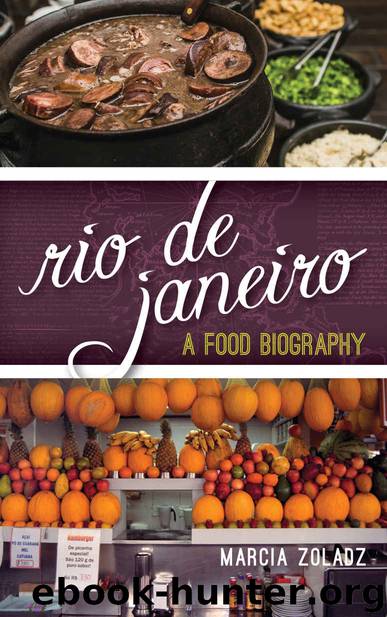Rio de Janeiro: A Food Biography (Big City Food Biographies) by Zoladz Marcia & Zoladz Marcia

Author:Zoladz, Marcia & Zoladz, Marcia [Zoladz, Marcia]
Language: eng
Format: epub
Publisher: Rowman & Littlefield Publishers
Published: 2016-09-01T16:00:00+00:00
Even More Immigrants
In order to explain the arrival of immigrants from countries other than Portugal in Rio, it is necessary to understand how large groups of Europeans moved to Brazil instead of the United States or Argentina, two important centers of immigration during the second half of the nineteenth century.
The Portuguese Crown and, later, Brazilian governments throughout the nineteenth century and the start of the twentieth signed collective contracts allowing large groups to establish themselves in Brazil in prearranged areas to work in predetermined activities. The Swiss, the first group, had 261 families with 1,681 persons. They arrived in 1820, from Fribourg and were sent to Nova Friburgo, a region in the mountains to the north of Rio, the mountain chain Serra do Mar, where there are valleys and plateaus with orchards and gardens. Not all of them were farmers, but as a way out of poverty in their original land, they had accepted contracts to work as farmers on Brazilian coffee plantations. It was not a successful enterprise, however, and soon they established themselves in the town or in Rio.
The experience was repeated with a group of Germans arriving in 1824, which was more successful. First of all, they were farmers, and they were living in a rural area similar to their own on the southern frontier of Brazil. Each family received twenty-seven acres of land to cultivate. More Germans, Russians, Poles, and Italians mostly from the Veneto arrived at colonies in the south in the same small-property model. This would end up also establishing a series of towns, large plantations or large farms, and large cities, now common in central and southeast Brazil.
The second wave of immigrants came to Brazil under an ill-fated concept that slaves on large coffee plantations in the state of São Paulo could be replaced by European farm laborers. As the Brazilian imperial government well understood that slavery would soon end, an immigration contract was established with the Veneto region in today’s northern Italy. The immigrants started to arrive in 1870, and their number grew steadily, with 515,533 arriving in the decade from 1884 to 1893, and another 537,784 in the next decade.4
This second kind of contract was different. These groups arrived much later, after the Italian unification in 1870, and they came to work as laborers on the coffee farms inland from São Paulo. However, this area had a large plantation economy based on slave work, lacking adequate lodgings and adequate agricultural equipment, and it would not willingly letting go of the old model. Therefore, a large number of the immigrants would leave for the towns close to the farms or to São Paulo.
As often happens when people are escaping famine, the Brazilian immigrants tended to accept any offered job. But such contracts had problems on both sides, for the farmers did not always honor their contracts, offering terrible working conditions, and on the other side, quite often many of the newly arrived were from cities, and they soon left the farms to work in occupations they really wanted or knew.
Download
This site does not store any files on its server. We only index and link to content provided by other sites. Please contact the content providers to delete copyright contents if any and email us, we'll remove relevant links or contents immediately.
| Culinary Biographies | Essays |
| Food Industry | History |
| Reference |
A Court of Wings and Ruin by Sarah J. Maas(7653)
The Death of the Heart by Elizabeth Bowen(3553)
The Sprouting Book by Ann Wigmore(3543)
Better Homes and Gardens New Cookbook by Better Homes & Gardens(3526)
BraveTart by Stella Parks(3395)
Salt, Fat, Acid, Heat: Mastering the Elements of Good Cooking by Nosrat Samin(3108)
Sauces by James Peterson(3051)
Kitchen confidential by Anthony Bourdain(3014)
The Bread Bible by Rose Levy Beranbaum(3004)
Classic by Mary Berry(2942)
Solo Food by Janneke Vreugdenhil(2931)
Ottolenghi - The Cookbook by Yotam Ottolenghi(2871)
Martha Stewart's Baking Handbook by Martha Stewart(2797)
Day by Elie Wiesel(2720)
Betty Crocker's Good and Easy Cook Book by Betty Crocker(2681)
The Plant Paradox by Dr. Steven R. Gundry M.D(2548)
My Pantry by Alice Waters(2547)
The Kitchen Counter Cooking School by Kathleen Flinn(2489)
Hot Sauce Nation by Denver Nicks(2451)
